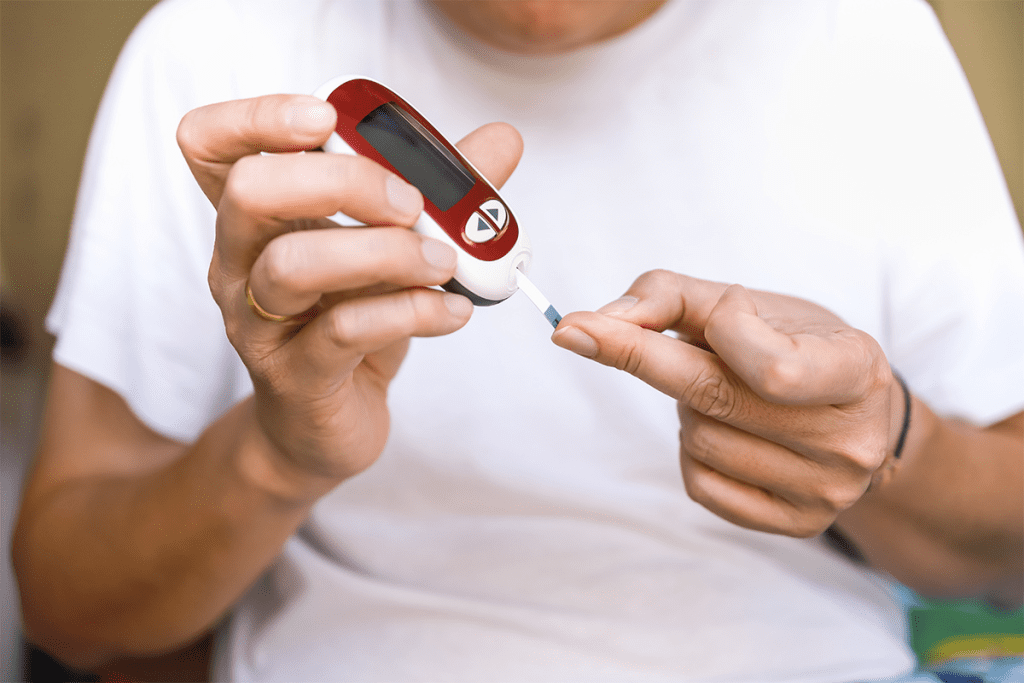Last Updated on November 14, 2025 by
Children can become pre-diabetic due to a mix of genetic, behavioural, and environmental factors. These factors raise their blood sugar levels, but not to the point of Type 2 diabetes.
It’s important to understand what is prediabetes. It’s a condition where blood glucose levels are higher than normal but not high enough for Type 2 diabetes. At LivHospital, we stress the need for early action to stop diabetes from developing.

Pre-diabetes in children is caused by a combination of genetic predisposition, unhealthy diet, and lack of exercise. By watching and managing these factors, we can stop pre-diabetes from turning into diabetes. Prediabetes A1C in children can signal future diabetes. Learn early symptoms, risk factors, and prevention strategies to protect kids.
It’s important to know about prediabetes in kids early. This is when blood sugar is higher than normal but not at a diabetic level. Early action can stop serious health problems later.
Prediabetes in kids means blood sugar is higher than normal but not at a diabetic level. Doctors use simple blood tests to check. These include fasting blood glucose, oral glucose tolerance test, and Hemoglobin A1c (HbA1c) levels.
“The American Diabetes Association says an A1c level of 5.7% to 6.4% means a kid has prediabetes,” a key range for doctors to spot at-risk kids.

The HbA1c test shows blood sugar levels over 2-3 months. An A1c of 5.7% to 6.4% means blood sugar is too high. Catching it early with A1c tests can stop type 2 diabetes.
Spotting early signs of prediabetes in kids is key. Look for thirst, urination, feeling tired, and blurry vision. Even without symptoms, knowing these signs can lead to a doctor’s visit.
“Finding and treating prediabetes early is vital to stop it from becoming type 2 diabetes,” stressing the need for watchfulness and active healthcare.
Prediabetes is becoming more common in U.S. kids. Recent numbers show a big jump. This is worrying because it means more kids might get type 2 diabetes and other health problems.

In 2023, almost 33% of U.S. teens aged 12“17 had prediabetes. This is a condition with high blood sugar but not diabetes. It’s a big warning sign for the health of young people in the U.S.
Many factors lead to prediabetes in teens. Eating too much sugar and not being active are big risks. Kids who don’t move much and eat lots of sugar are more likely to face insulin resistance, a sign of prediabetes.
The number of teens with prediabetes went from 20% to 33%. This big increase shows we need to act fast to find and fix the problems causing it.
Many things contribute to this rise. More kids are overweight, don’t move much, and eat unhealthy foods. Knowing these reasons is key to stopping prediabetes before it starts.
Some kids are more likely to get prediabetes. This includes those with a family history of diabetes, who are overweight or obese, and who don’t move much. These factors increase their risk.
Doctors use the hemoglobin A1c test to check for prediabetes. A level between 5.7% and 6.4% means a kid might have prediabetes.
By knowing who’s at risk and taking action, we can lower the number of kids with prediabetes. This helps prevent serious health problems later on.
Several key factors contribute to the development of prediabetes in children. These include lifestyle and genetics. Knowing these risk factors is key for early detection and treatment.
Obesity is a big risk for prediabetes in kids. An elevated Body Mass Index (BMI) often means insulin resistance. This is when the body’s cells don’t use insulin well, causing high blood sugar.
Studies show kids with obesity tend to have higher hemoglobin a1c 5.8 levels. This is in the prediabetic range.
Not enough physical activity is another big risk for prediabetes in kids. Being inactive leads to insulin resistance and high A1c levels. Encouraging kids to be active, like through sports or playing outside, can help.
Diet is very important in developing prediabetes. Eating too much sugar and processed foods can cause insulin resistance and high blood sugar. Parents can help by teaching healthy eating habits.
Limiting sugary drinks and encouraging whole, nutrient-rich foods is key.
A family history of diabetes is a big risk for prediabetes in kids. Kids with a family history of Type 2 diabetes are more likely to develop insulin resistance and prediabetes.
By knowing these risk factors, parents and healthcare providers can help prevent Type 2 diabetes. Monitoring A1c levels, like checking for pre diabetic range hba1c, is very important.
It’s important to know the health risks of prediabetes in kids. Prediabetes, shown by an A1c level of 5.7% to 6.4%, is more than a warning. It’s a chance to stop more serious health problems before they start.
Prediabetes can turn into Type 2 diabetes if not treated. Kids with prediabetes are at risk of getting Type 2 diabetes. This disease used to only affect adults, but is now seen in kids too.
Factors like being overweight, not being active, and eating too much sugar or unhealthy fats can make it worse. Changing your lifestyle early can help. It can make your body more sensitive to insulin.
Prediabetes is not just a step towards diabetes. It also raises the risk of heart disease. Kids with prediabetes might start showing signs of heart problems early.
These signs can lead to atherosclerosis, where arteries get clogged. Prediabetes also causes dyslipidemia and hypertension. These can make heart disease more likely later on.
The mental effects of prediabetes or metabolic disorders in kids should not be ignored. They might feel anxiety and depression because of diet changes and lifestyle adjustments.
Being overweight or having a chronic condition can also hurt their self-esteem and how they interact with others. Healthcare providers need to support and guide them through these tough times.
In summary, prediabetes in kids has many health risks. These include getting Type 2 diabetes, heart and metabolic problems, and mental health issues. Finding and treating it early is key to keeping kids healthy and happy for the long term.
It’s key to know what prediabetes is and its effects on kids. Prediabetes, shown by high pre diabetes a1c levels, is a warning. It needs quick action.
We stress the need for proven ways to fight prediabetes in kids. Making healthy food choices and exercising often can help. These steps can make insulin work better, reverse prediabetes, and stop Type 2 diabetes from starting.
Using these proven methods can lower the risk of heart and metabolic problems linked to prediabetes. It’s vital to work with doctors to create a plan that fits each child’s needs.
Acting early and choosing a healthy lifestyle can greatly help kids with prediabetes. We must be proactive to stop Type 2 diabetes and keep kids healthy.
Prediabetes in kids means their blood sugar is higher than normal but not high enough to be called Type 2 diabetes. It’s when their A1c level is between 5.7% and 6.4%. This shows they might get Type 2 diabetes later.
An A1c level between 5.7% and 6.4% means a child has prediabetes. For example, an A1c of 5.7, 5.8, or 5.9 shows prediabetes. But a level below 5.7% is normal.
Signs of prediabetes in kids include being thirsty and urinating a lot, feeling tired, blurry vision, and cuts healing slowly. But, prediabetes often doesn’t show symptoms. So, regular check-ups and A1c tests are key for catching it early.
Risk factors for prediabetes in kids include being overweight, not being active, eating poorly, and having a family history of diabetes. These can cause insulin resistance and raise blood sugar levels.
Making healthy changes can help prevent Type 2 diabetes in kids with prediabetes. Eating well, being active, and keeping a healthy weight can improve insulin sensitivity and metabolic health.
If not treated, prediabetes in kids can lead to Type 2 diabetes, heart problems, and mental health issues. Early action is key to avoiding these problems and ensuring good health later on.
About 33% of U.S. teens have prediabetes. Kids from families with a history, those who are overweight or obese, and those who don’t move much are at higher risk.
Subscribe to our e-newsletter to stay informed about the latest innovations in the world of health and exclusive offers!